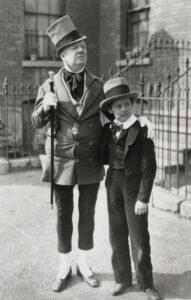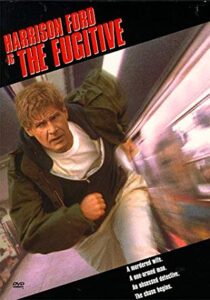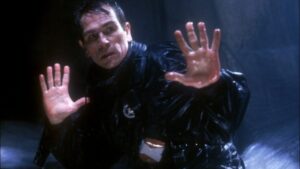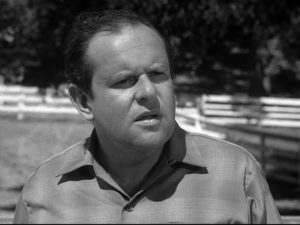by James Scott Bell
@jamesscottbell

W. C. Fields as Wilkins Micawber; Freddy Bartholomew as David in MGM’s David Copperfield (1935)
When it comes to minor characters, what you don’t want is the bland leading the bland. That’s why I call minor characters “spice.” Just the right amount can turn an average reading experience into a tasty delight. It’s the difference between plain yogurt and Rocky Road, or chicken broth and mulligatawny.
Minor characters, as I use the term, are to be distinguished from Main and Secondary characters.
Main characters are Rick, Ilsa, Laszlo, Louis in Casablanca. They have the most to do with the plot.
Secondary are recurring characters who have some importance to the plot, like Major Strasser and Sam the piano man.
Minor characters are those who appear for various reasons to complicate or relieve matters (comic relief is a great tool in thrillers and suspense). In Casablanca there are a number of these, from Ugarte (Peter Lorre) to the desperate Bulgarian wife (Joy Page) to Carl the waiter (S. Z. “Cuddles” Sakall).
A subset of minor characters are those who appear once, necessary to a scene. Taxi drivers, doormen, barbers, and the like.
Consider now the uses of minor characters.
Essential Plot Information
There are any number of times when a main character needs some inside information. The cliché is the shoeshine guy who knows what’s happening on the street.
My favorite send-up of this trope is from the old TV show Police Squad, starring Leslie Nielsen as the cop. He gets into the shoeshine chair and slips Johnny a bill to tell him what’s what. The hilarious part is that while Johnny knows everything going on crime-wise, he also knows everything about everything. So when a priest sits down and asks, “What do you know about life after death?” Johnny answers, “I wouldn’t know anything about it.” The priest slips him a bill. Johnny says, “You talking existential being or anthropomorphic deity?”
It is Ugarte in Casablanca who delivers the MacGuffin to Rick—the letters of transit.
Deepening Main Characters
How a main character interacts with a minor character can reveal a great deal.
Here’s some advice from James “The Love Doctor” Bell. If you plan to get married, observe how your intended treats the server in a restaurant, or the checkout person at the grocery store.
What I call the “Pet the Dog” beat can be used for this. Think of Dr. Richard Kimble in The Fugitive (see my post here). He takes a risk to help a dying boy in the hospital, even though it leads to more trouble.
Or Rick, who helps the husband of the Bulgarian wife get the money they need to buy papers, instead of her having to sleep with Louis to get them. Louis observes this and makes note of it. More trouble for Rick.
Setting Richness
A minor character can lend color to an unfamiliar setting. This is a good addition to description. Seeing and hearing characters in their element adds to the tone and feel of a scene.
In the Harrison Ford movie Witness, John Book (Ford) is a cop who has to hide out among the Amish to avoid assassination and protect the Amish boy who can identify a murdering cop (played by Danny Glover). His interactions with various characters and their ways are evocative:
Scene Tension
Here’s an underused tip: put two minor characters in opposition in a scene as the main character is trying to advance the plot. In Long Lost I have two elderly women who volunteer at the reception desk of a local hospital. As my main character attempts to gain access, the two of them, dubbed Curls and Red by the main, snipe at each other, adding a further obstacle. I got this idea from my great aunts, one a widow and the other a divorcee, who lived together. When I’d visit, they’d put out the See’s candy and give each other little verbal jabs as they recalled family stories.
Plot Juice
Raymond Chandler famously said that if things get slow, just bring in a guy with a gun. Of course, it doesn’t have to be a guy or a gun, but a minor character with something of importance.
Hammett does this in The Maltese Falcon. Spade has had no luck finding the black bird. Then one night a man riddled with bullets stumbles into his office, hands him a bundle, and dies. Turns out the stiff is the captain of a ship and the bundle is, you guessed it, the falcon.
Wrapping Up a Mystery
Sometimes you get to the end of a book and there are plot threads that need to be accounted for (you pantsers know what I’m talking about!). Now what?
Well, a minor character can show up with the essential information. You can create such a character on the spot. But then you have to do something else—go back into the book and find a scene or two to plant this character. Otherwise, it will be a Deus ex machina.
I’ll leave you with a couple of tips for creating memorable minor characters.
Avoid stereotypes. They are usually the first picture to spring to mind because we’ve seen them so many times before. The bartender wiping a glass. The truck driver in boots and cowboy hat or baseball cap. Just take a moment to change things up. Maybe the bartender knits. Maybe the truck driver is a woman who likes dresses. You’re the writer, come up with something new.
Tags of manner and speech. Give each minor character one unique tag of manner and one of speech. Dickens was a master at this. Think of Uriah Heep, always rubbing his hands together and smarmily talking about how ’umble he is. Or Wilkins Micawber, who always uses twenty words when five would do. David describes him as—
a stoutish, middle-aged person, in a brown surtout and black tights and shoes, with no more hair upon his head (which was a large one, and very shining) than there is upon an egg, and with a very extensive face, which he turned full upon me. His clothes were shabby, but he had an imposing shirt-collar on. He carried a jaunty sort of a stick, with a large pair of rusty tassels to it; and a quizzing-glass hung outside his coat,—for ornament, I afterwards found, as he very seldom looked through it, and couldn’t see anything when he did.
That’s how you major in minors.
Who are some of you favorite fictional minor characters? How about in you own fiction?




